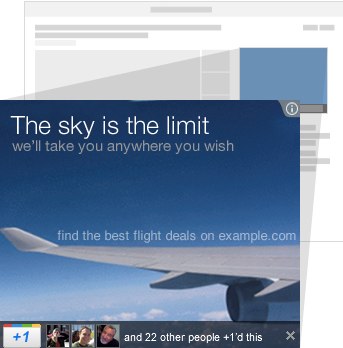Google +1s On Ads Added To Google Display Network, Will Influence Auction
Search AdWords have had +1 buttons since late May, and now the +1 functionality is coming to the Google Display Network (GDN). Additionally, +1 data will, for the first time, serve as a signal of relevance in the AdWords auction — for display only, for now. As with the +1s that accompany text ads, people […]

As with the +1s that accompany text ads, people who see ads on the display network will be able to see whether someone Google knows to be connected to them has +1ed the landing page associated with the ad. The total number of +1s could also be displayed. The +1s could have been done on the marketers’ Web site, in organic search results, or in the ad environment — they’re all aggregated by landing page URL. To determine connections, Google looks at things like people’s Gmail contacts, who they’ve added to Google+ Circles, and who they follow in Google Reader. To +1 something, a user must be logged into their Google account.
+1s Affecting The Auction
If a person +1s a site or ad, display ads in the network associated with that URL will have a better chance of being displayed when their friend visits any page in the network — so long as all the advertiser’s targeting conditions are met. In a blog post, Google refers to it as an “extra boost.” So, in addition to bid price and quality score, robust +1 activity will be rewarded.
“When an ad is personally annotated, there’s a positive impact on click-through rate,” Christian Oestlien, Lead Product Manager for Social Advertising, told me. “You get this great win of users becoming advocates for your product…you can take advantage of social and you don’t need to come up with new metrics. All of this is baked into all of your existing ad campaigns.”
Comments like Oestlein’s make it clear that Google is aiming for Facebook with this social targeting, imitating, and trying to go beyond, “friend of a friend” on the social networking giant.
And, although the auction boost applies only to the GDN for now, higher click-through activity generated by +1-ed ads will raise the account’s overall status with Google, perhaps influencing search ad auctions, as well. Eventually, +1s could more directly impact search ads.
“It’s something we’re watching. Obviously, the quality score is an important dynamic to search ads,” said Jim Prosser, a Google spokesperson. “Any changes done to that is done in a careful and deliberate way — display is a different world and a different beast, and we use different methodologies.”
Hopes To Increase Participation By Users
Google hopes that adding +1s will also encourage users to engage more with advertising on the web in general, given that nearly every web user encounters the GDN likely every day, if not multiple times a day.
“We think that’s an incredible win for the end user and will motivate people to proactively participate in advertising,” says Oestlien. “Their friends start to see more of those quality creatives and people become more engaged with ads on the internet.”
It will also likely motivate more advertisers to incorporate +1 buttons on their own Web sites, hoping to garner some of the +1 boost to their display ads.
The new display ad +1 buttons will be available for image, animated GIF, Flash, Display Ad Builder ads and certain mobile inventory. Advertisers may also include the +1 button on DoubleClick Rich Media ads, whether they are running on the GDN or elsewhere. Advertisers may also opt out of having +1s with their ads altogether, and, as of today, they can opt out of +1 at the campaign level. Additionally, end-users and publishers can also opt-out of seeing +1s or displaying them on their sites.
The changes won’t appear immediately. To give advertisers and publishers time to opt-out if they’d like to, Google is rolling the changes out in a couple of weeks.
Related stories
New on Search Engine Land